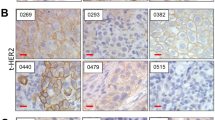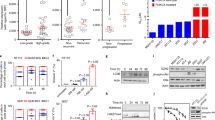Abstract
The PTEN gene, located on chromosome 10, is a phosphatase in the phosphatidylinositol 3′-kinase (PI3'K)-mediated signal transduction pathway. PTEN inhibits the activation of Akt, a serine–threonine kinase involved in proliferative metabolic and antiapoptotic pathways, and has tumor suppressive properties. We created a PTEN adenoviral vector, Ad-MMAC, to assess the role of PTEN in the treatment of bladder cancer. Direct injection of Ad-MMAC into established subcutaneous UM-UC-3 (PTEN deleted, upregulation of phosphorylated Akt) and UM-UC-6dox (wild-type PTEN, upregulation of phosphorylated Akt) tumors in nude mice resulted in PTEN expression, apoptosis, and significantly decreased growth compared to Ad-CTR- or Phosphate-buffered saline (PBS)-treated tumors. UM-UC-3 tumors completely disappeared in all of mice treated with Ad-MMAC, but PBS- and Ad-CTR-treated UM-UC-3 tumors continued to grow rapidly. UM-UC-14 tumors (wild-type PTEN) were transiently suppressed by Ad-MMAC. Downregulation of vascular endothelial growth factor and decreased microvessel density were seen in tumors treated with Ad-MMAC in vivo. Combination therapy with Ad-MMAC and doxorubicin improved the in vivo efficacy of PTEN gene therapy in the doxorubicin-resistant cell line UM-UC-6dox. Treatment with Ad-MMAC and doxorubicin completely eradicated established UM-UC-6dox tumors in three of 10 mice. UM-UC-14 tumors were transiently suppressed by this combined treatment. These data demonstrate that PTEN gene therapy can effectively treat bladder cancers that have genomic alterations in PTEN. Furthermore, tumors that exhibit drug resistance associated with expression of phosphorylated Akt can be effectively treated with PTEN gene therapy and chemotherapy.
This is a preview of subscription content, access via your institution
Access options
Subscribe to this journal
Receive 12 print issues and online access
$259.00 per year
only $21.58 per issue
Buy this article
- Purchase on Springer Link
- Instant access to full article PDF
Prices may be subject to local taxes which are calculated during checkout







Similar content being viewed by others
References
Greenlee RT et al. Cancer Statistics 2000, CA Cancer J Clin 2000; 50: 7–33.
Lamm DL et al. Maintenance bacillus Calmette-Guerin immunotherapy for recurrent TA, T1 and carcinoma in situ transitional cell carcinoma of the bladder: a randomized Southwest Oncology Group Study. J Urol 2000; 163: 1124–1129.
Herr HW . Natural history of superficial bladder tumors: 10- to 20-year follow-up of treated patients. World J Urol 1997; 15: 84–88.
Cookson MS et al. The treated natural history of high risk superficial bladder cancer: 15-year outcome. J Urol 1997; 158: 62–67.
Davies MA et al. Adenoviral transgene expression of MMAC1/PTEN in human glioma cells inhibits Akt activation and induces anoikis. Cancer Res 1998; 58: 5285–5290.
Davies MA et al. Regulation of Akt/PKB activity, cellular growth, and apoptosis in prostate carcinoma cells by MMAC/PTEN. Cancer Res 1999; 59: 2551–2556.
Tanaka M et al. MMAC1/PTEN inhibits cell growth and induces chemosensitivity to doxorubicin in human bladder cancer cells. Oncogene 2000; 19: 5406–5412.
Folkman J . Clinical applications of research on angiogenesis. N Engl J Med 1995; 333: 1757–1763.
Fidler IJ, Ellis LM . The implications of angiogenesis for the biology and therapy of cancer metastasis. Cell 1994; 79: 185–188.
Blaese M et al. Vectors in cancer therapy: how will they deliver? Cancer Gene Ther 1995; 2: 291–297.
Spruck III CH et al. Two molecular pathways to transitional cell carcinoma of the bladder. Cancer Res 1994; 54: 784–788.
Vet JA et al. Comparison of P53 protein overexpression with P53 mutation in bladder cancer: clinical and biologic aspects. Lab Invest 1995; 73: 837–843.
Duggan BJ et al. Molecular targets for the therapeutic manipulation of apoptosis in bladder cancer. J Urol 2001; 165: 946–954.
Cheney IW et al. Suppression of tumorigenicity of glioblastoma cells by adenovirus-mediated MMAC1/PTEN gene transfer. Cancer Res 1998; 58: 2331–2334.
Sakurada A et al. Adenovirus-mediated delivery of the PTEN gene inhibits cell growth by induction of apoptosis in endometrial cancer. Int J Oncol 1999; 15: 1069–1074.
Wen S et al. PTEN controls tumor-induced angiogenesis. Proc Natl Acad Sci USA 2001; 98: 4622–4627.
Huang J, Kontos CD . PTEN modulates vascular endothelial growth factor-mediated signaling and angiogenic effect. J Biochem Chem 2002; 277: 10760–10766.
Huang H et al. PTEN induces chemosensitivity in PTEN-induced prostate cancer cells by suppression of Bcl-2 expression. J Biochem Chem 2001; 276: 38830–38836.
Shah MA, Schwartz GK . Cell cycle-mediated drug resistance: an emerging concept in cancer therapy. Clin Cancer Res 2001; 7: 2168–2181.
Thakkar H et al. Pro-survival function of Akt/protein kinase B in prostate cancer cells: relationship with trail resistance. J Biol Chem 2001; 276: 38361–38369.
Thakar M et al. Akt enables Ewing's sarcoma family of tumors to survive doxorubicin therapy. Proc Am Assoc Cancer Res 1999; 40: 633 (Abstr. 4172).
Nielsen LL et al. Derivation and initial characterization of a mouse mammary tumor cell line carrying the polyomavirus middle T antigen: utility in the development of novel cancer therapeutics. Cancer Res 2000; 60: 7066–7074.
Schondorf T et al. Interaction of cisplatin, paclitaxel and adriamycin with the tumor suppressor PTEN. Anticancer Drugs 2001; 12: 797–800.
Mayo LD et al. PTEN protects p53 from Mdm2 and sensitizes cancer cells to chemotherapy. J Biochem Chem 2002; 277: 5484–5489.
Pu YS et al. Expression of MDR-1 gene in transitional cell carcinoma and its correlation with chemotherapy response. J Urol 1996; 156: 271–275.
Sanberg AA, Berger CS . Review of chromosome studies in urological tumors. II. Cytogenetics and molecular genetics of bladder cancer. J Urol 1994; 151: 545–560.
Cappellen D et al. Frequent loss of heterozygosity on chromosome 10q in muscle-invasive transitional cell carcinomas of the bladder. Oncogene 1997; 14: 3059–3066.
Cairns P et al. Point mutation and homozygous deletion of PTEN/MMAC1 in primary bladder cancers. Oncogene 1998; 18: 3215–3218.
Aveyard JS et al. Somatic mutation of PTEN in bladder carcinoma. Br J Cancer 1999; 80: 904–908.
Grossman HB et al. Improved growth of human urothelial carcinoma cell cultures. J Urol 1986; 136: 953–959.
Liebert M et al. The monoclonal antibody BQ16 identifies the alpha 6 beta 4 integrin on bladder cancer. Hybridoma 1993; 12: 67–80.
Shinohara N et al. Evaluation of multiple drug resistance in human bladder cancer cell lines. J Urol 1993; 150: 505–509.
Graham FL, Prevec L . Methods for construction of adenovirus vectors. Mol Biotechnol 1995; 3: 207–220.
Tanaka M et al. Gelsolin: a candidate for suppressor of human bladder cancer. Cancer Res 1995; 55: 3228–3232.
Tanaka M, Grossman HB . Connexin 26 gene therapy of human bladder cancer: induction of growth suppression, apoptosis, and synergy with cisplatin. Hum Gene Ther 2001; 12: 2225–2236.
Doug Z et al. Suppression of angiogenesis, tumorigenicity, and metastasis by human prostate cancer cells engineered to produce interferon-β. Cancer Res 1999; 59: 872–879.
Yano S et al. Expression of vascular endothelial growth factor is necessary but not sufficient for production and growth of brain metastasis. Cancer Res 2000; 60: 4959–4967.
Weidner N et al. Tumor angiogenesis and metastasis: correlation in invasive breast carcinoma. N Engl J Med 1991; 324: 1–8.
Acknowledgements
This work was supported in part by the American Foundation for Urologic Disease and grant CA16672 from the National Cancer Institute.
Author information
Authors and Affiliations
Rights and permissions
About this article
Cite this article
Tanaka, M., Grossman, H. In vivo gene therapy of human bladder cancer with PTEN suppresses tumor growth, downregulates phosphorylated Akt, and increases sensitivity to doxorubicin. Gene Ther 10, 1636–1642 (2003). https://doi.org/10.1038/sj.gt.3302056
Received:
Accepted:
Published:
Issue Date:
DOI: https://doi.org/10.1038/sj.gt.3302056
Keywords
This article is cited by
-
Cell fusion upregulates PD-L1 expression for evasion from immunosurveillance
Cancer Gene Therapy (2023)
-
PTEN/PTENP1: ‘Regulating the regulator of RTK-dependent PI3K/Akt signalling’, new targets for cancer therapy
Molecular Cancer (2018)
-
miR-92b regulates glioma cells proliferation, migration, invasion, and apoptosis via PTEN/Akt signaling pathway
Journal of Physiology and Biochemistry (2016)
-
Phosphatidylinositol- 3-kinase inhibitor induces chemosensitivity to a novel derivative of doxorubicin, AD198 chemotherapy in human bladder cancer cells in vitro
BMC Cancer (2015)
-
Establishment and characterization of a bladder cancer cell line with enhanced doxorubicin resistance by mevalonate pathway activation
Tumor Biology (2015)



